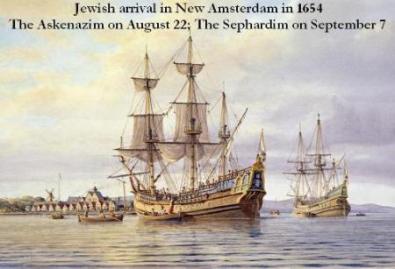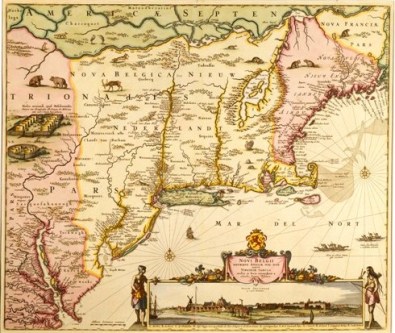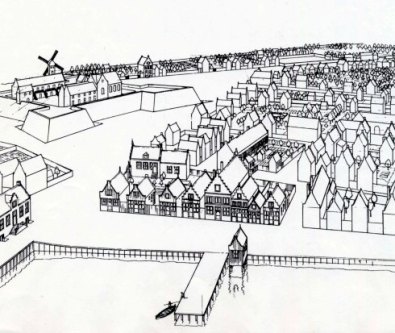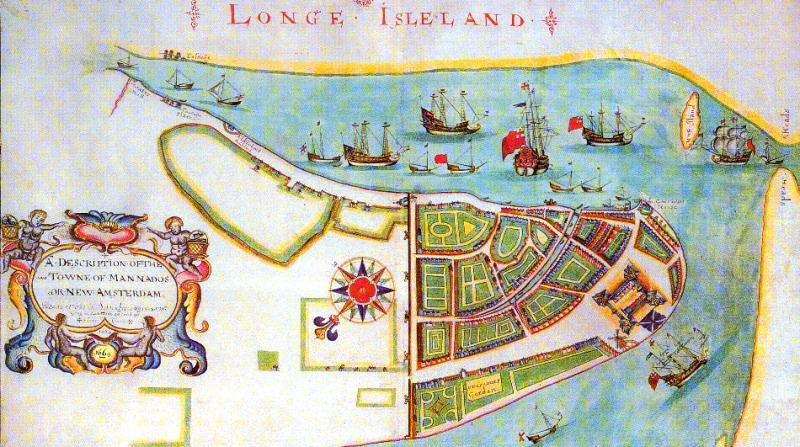|
|
|
GovIsland Park-to-Tolerance: through Broad Awareness and Conscious Vigilance
|

As
the place of first European settlement in the New York Tri-State region and as the juridical wellspring of American toleration
(= religious Tolerance), Governors Island—an imaginative
canvas of global meaning and 21st-century thematic substance—when revealed as America's historic symbol
of Tolerance upon politicial acceptance, increases the worth of the Statue of Liberty.
Namely, Tolerance is the foundational principle for liberty. This Governors Island legacy and New York State's birthright are immensely pertinent to the successful
future of our diverse nation because the reciprocal dynamic of Tolerance defines personal
freedom (= liberty) thereby distinguishing it from “STATIC” or “GENERIC” freedom. The innovative Tolerance Park—a moral landscape and palpably contemporary masterpiece—will
recall the birth and childhood of the region now popularly referred to as the New York Tri-State and will reflect on what
it takes to COEXIST successfully in terms of religion, ethnicity and race in the appreciation of American freedom. These topics are not about the past but are contemporary and also exceptionally pertinent
to the success of our future as a liberalist, democratic nation. Intolerance impairs democracy and may even destroy
it. With a 151 feet high Tolerance Monument as centerpiece, the GovIsland Park-to-Tolerance—which will use only 30% of Governors Island—will
be a place of educational significance to the nation and a showcase of the New York Tri-State’s earliest, as well as
third-millennium architectural and material culture (see Vision Statement below).
|
|
New York
City, originally named New Amsterdam, is the historical extension and cultural product
of Amsterdam. There, the Amsterdam-born philosopher Baruch or Benedict de Spinoza, a member of the Portuguese Israelite community, wrote in 1670: "Ours has befallen a rare fortune to live in a republic
where everyone is allowed complete freedom of conscience and God worship and where one doesn't consider anything more precious
and loving than liberty." In his Tractatus Theologico-Politicus he
stated that "the city of Amsterdam leads the fruit of this freedom in its own great prosperity and in the admiration
of all other people. For in this most flourishing state and most splendid city, men of every nation and religion live together
in the greatest harmony...his religion and sect is considered of no importance... In fact, the true aim of government is liberty"
(Chapter 20, paragraph 6: "Finis ergo Reipublicae revera libertas est.")
|

|
|

This 1651 map was engraved from a 1648 manuscript map produced in Manhattan. Its creation represents a historic decision of profound importance to American history
because it illustrates one’s legal right to seek redress of grievances by directly petitioning the highest level of
government—143 years before codification of that right in the First Amendment of the Bill of Rights; “Congress
shall make no law abridging the right of the people to petition the government for a redress of grievances.” For detailed article click on "Right to Seek Redress of Grievances" (Try a few times to awaken archived site).
The MAGNUM OPUS of the GovIsland
Park-to-Tolerance The meaning of Governors Island lies in its existence
as unrecognized Conceptual Art since 1624. Its transformation to Visual Art and National Symbol is to be accomplished
by a living museum-park to tolerance. It will be the nation’s first park
that addresses issues of dynamic tolerance as they define American freedom. The Tolerance Park will not be a corney project of personality, skewed identity promotions or dreamy imaginings but a modern creation as a palpable reflection of the past
and of hardcore relevance. It will be the place where 350 years of contrasts will visually dissolve harmoniously into a new
and unique quilt, just as divergences and boundaries melt away through the ethical force of tolerance into common
humanity. At least twenty percent
of the village structures will be exclusively devoted to interactive educational exhibits on religious, ethnic and racial
tolerance (see Tolerance Walk.) The remaining structures of the living museum tableau will serve as America's FIRST MIXED-USE URBAN ARTISTS COLONY
THAT FOCUSES ON ARTS AND CRAFTS WITH EMPHASIS ON VANISHING ARTS AND CRAFTS DISCIPLINES FROM BEFORE THE 19th-CENTURY. GovIsland Park-to-Tolerance will be the
premier international source for the learning and practicing of trades as performed in the early European guilds as well as
a resource for the maintenance, preservation and conservation of various nations' artistic and cultural heritages. Visually reflecting harmony-in-difference and humility, workspace
or housing will be provided behind unique facades and along the shoreline behind authentic, seventeenth-century or in reconstructed
as well as transplanted preserved buildings or barns. The Tolerance Park will also include formal and botanical period gardens. The 50-acre canvas for organic creativity will
defend "American" freedom intellectually and visually by linking New York's original 1624 legal-political tradition
of the inseparable dual notion of Tolerance and Liberty with America's contemporary
principles which sustain our heritage. The
Tolerance Park’s unique functions will serve as a magnet for people from all over the world. Its omnipresence will guarantee
an endless qualitative and positive economic, artistic and intellectual effect on New York City while radiating the active
dynamic of Tolerance as the defender and definer of American Freedom. As these freedoms are guaranteed in the American
Constitution, the GovIsland Park's exhibits will not advance or be reflective of religious, political or personal beliefs
and agendas. The GovIsland Park will serve as global locus for debates, conferences and educational
programming pertaining to the topic of Tolerance—a primary American value as well as a fundamental
individual right under the United States Constitution, and so acknowledged and defined as a universal value by Unesco—and
will dialogue, on the intellectual level, with contemporary society. Please address any communications to President@TolerancePark.org. For some architectural sensibilities on the extremities
CLICK HERE.
|

CREATIVE VISION STATEMENT of MASTERPIECE on FIFTY-ACRE CANVAS (30%
of GOVERNORS ISLAND) Most European towns evolved
from medieval times around a central market square. Those historical squares still form the core of many great cities like
Antwerp, Haarlem, Bruges, Utrecht, Ghent and Gouda. Typically, they comprise the town’s historically most important
and meaningful contemporary structures such as a cathedral as cultural beacon of grandeur, a town hall, a weigh house or statuary
from the 13th through 17th centuries. Today, those celebrated town
centers often function as traffic-free oases and meeting points. They foster community and serve as magnets for socializing
among diverse layers of residents and visitors alike. Outside the perimeters of those early towns—usually
typified by protective moats or walls (as in, for example, Wall Street in 1653)—subsequent
growth was accommodated. Those urban additions—radiating outward from the town’s historical core—often
emerged in concentric circles of architectural styles unique to their period. That architectural chronology will be reversed
on the GovIsland Park-to-Tolerance. Namely, the view from the water
will be on authentic 17th-century [New Amsterdam] Netherlandic facades. Walking from the shoreline
towards the Tolerance Park’s core, one will arrive at an inviting, warm, people-friendly market square surrounded by
ornamented or embellished facades of 21st-century architectural uniqueness and cohesiveness and therefore reflective of harmony-in-difference—the ideal condition of the virtue of Tolerance. The square will be built around a third millennium Tolerance Monument of global meaning, thematic substance and 21st-century visual greatness like, for instance, a 151 ft (46 meters) high
appropriation of Barnett Newman's inspiration to fuse two disparate Egyptian icons - a pyramid and an obelisk - into a unified
sculpture named Broken-Obelisk (a copy of which is in MoMA.) It was dedicated to the memory of Dr. Martin Luther King Jr. after his assassination in 1968. Doing so will integrate Broken-Obelisk's
history, meaning and cultural value into a new national symbol of eternal consciousness ( Click Here.) This iconic emblem with its implicit testimonial to racial tolerance
will comprise a Tolerance Hall to address issues of human servitude in modernity while placing special emphasis on the portrayal of this topic in the Atlantic Arena from the 15th through 17th centuries. Its height equates that of the Statue of Liberty’s without pedestal (that is,
half the total monument's height because Broken-Obelisk stands on the ground) as Tolerance and Liberty are the fratern al twins in the conception of American Freedom. It will highlight uplifting exhibits and narratives of Herculean courage as inspirational
demonstrations of humanity’s capacity for astonishing compassion that emerges from the depths of depravity and indifference.
The color of the pyramid section will be black to reflect its theme: "Black has
an innersound of nothingness bereft of possibilities, a dead nothingness as if the sun had become extinct"
so wrote Kadinsky. Because black’s cognate is blue, the upside-down obelisk section will be translucent to radiate blue
light as a blue-sky tribute to mankind’s power to rise and create ex nihilo. It will be situated on the same spot within
the Tolerance Park as where Fort Amsterdam was positioned within New Amsterdam on Manhattan. Just as when Governors Island became the region’s first crossroad of three cultures
in 1613, the GovIsland Park, when it opens in September 2009, will become a meeting point for the cultures
of the world to debate on these issues of profound importance to future generations. Consequently, the GovIsland Park-to-Tolerance will link visually the 1624 historic planting of the jurisprudence of religious Tolerance
(that is, the "father" of American liberty and the basis of successful pluralism) and Freedom of Conscience on Governors
Island with 21st-century awareness of the broader, dynamic ethical force of Tolerance as being
indispensable to religious, ethnic and racial equality and liberty in contemporary American society.
|
|

In March 1664, King Charles II resolved to annex New Netherland and to “bring all his Kingdoms under one
form of government, both in church and state, and to install the Anglican government as in old England.” New Netherland director-general Petrus Stuyvesant received one letter from his lord directors of the [Dutch] West
India Company just one month prior to the arrival of four English frigates on August 27, 1664. In the face of rumors of an
English invasion, his superiors attempted to make a virtue out of military weakness and suggested that liberty (freedom of
conscience in religion) did not need to be militarily defended and would take care of itself. They wrote; “we are
in hopes that as the English at the north (in New Netherland) have removed mostly from old England for the causes aforesaid,
they will not give us henceforth so much trouble, but prefer to live free under us at peace with their consciences than to
risk getting rid of our authority and then falling again under a government from which they had formerly fled.” A
few months later, in September that year, Stuyvesant's worst fears were realized. However, his administration negotiated the
continuation of that explicit founding condition of toleration in New Netherland in article VIII out of twenty-four articles
of [provisional] transfer. It guaranteed New Netherlanders, under future English jurisdiction, that they “shall
keep and enjoy the liberty of their consciences in religion.” That article was an affirmation of the existing
legal-cultural tradition of religious tolerance as the basis of ethnic diversity in New Netherland since 1624 and, particularly,
in its capital of New Amsterdam. It was to become New York State’s cultural-legal heritage when the juridical right
to toleration was re-introduced and codified as an individual liberty in New York State's first Constitution of 1777.
Twelve years later, the U.S. Congress proposed to the State Legislatures the juridical right to religious tolerance which
was promptly affirmed by New York's first Governor, George Clinton, and two years later, on December 15, 1791, was ratified
as the First Amendment of the Bill of Rights—“Congress shall make no law prohibiting the free exercise of
religion.” However, because state rights superseded the Constitution in the matter, this individual liberty became
finally available to all U.S. citizens in 1868 in a Bill of Rights amendment that barred states from abridging the
privileges or immunities of citizens. It rendered the promise of the First Amendment that all religions were to be equal and
free finally effective for all citizens, 244 years after it became available to the people in the New York region as
of 1624.
|
|
|
|
|
|
|
|
|


